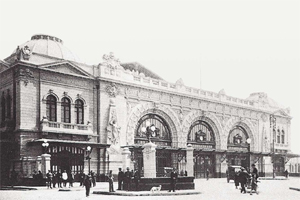Prior to the one hundred year anniversary of the First Government Junta, a special work group was put together to organize the celebration of Chile’s Centennial. Precisely in 1894, the Centennial of the Republic Commission was established, whose task was to propose projects and special activities for the festivities.
Later, in 1905, a new commission was formed, which was presided by the minister of the Interior at the time, Agustin Edwards McClure.
Once 1910 had arrived, from the beginning of the year Chile prepared itself to celebrate one hundred years of independent life.
Festivities and commemorative works were scheduled to reflect the progress made by Chile, as well as providing an opportunity to reflect upon the national reality.
However, it’s important to mention that the celebration of these 100 years took place in the shadow of the passing of two important authority figures. In August of 1910, president Pedro Montt travelled to Germany to receive treatment for his delicate health; nevertheless, he passed away a few days later, on August 16th of that year. Faced with the absence of the head of state, the administration of the country was taken over by Elias Fernandez Albano, who assumed as vice-president of the Republic. His government only lasted a few days, for he died of pneumonia on September 6th. In light of these events, a commission manned by political figures was put together, which decided to postpone the festivities of the country’s one hundred years of republican life.
Once the commission took shape, it was presided by the top authority of the country in the absence of the president and vice-president of the nation: the minister with the most years in service. That was Emiliano Figueroa Larrain, who had been the acting minister of Justice and Public Instruction for a year.
Centennial works
At the beginning of 1910, one of the first tasks for organizing the celebration of Chile’s one hundred years was to invite delegations from friendly countries. Thus, Chile played host to visitors from foreign nations, both American and European. Cultural activities were also arranged.
For example, literary and artistic contests, art exhibitions, and, to spread the word about national products, exhibitions were put together that showcased the results of the work performed by Chile’s industries and agriculture.
With the objective of beautifying the city, the inauguration of different public projects was scheduled for 1910. Among them, the Estacion Mapocho (Mapocho Station) and the Palacio de Bellas Artes (Palace of Fine Arts).
The installation of sewage systems was completed and the capital’s new public lighting grid was powered on.
Likewise, commemorative monuments were inaugurated, including some which were donated by foreign colonies residing in Chile. Also, historical documents were published relating to the Government Junta of 1810, the independence of Chile and other important topics concerning the history of the country.
Palace of Fine Arts
It was inaugurated on September 21st, 1910, by the vice-president of the Republic at the time, Emiliano Figueroa.
Since that date it has housed the Museum of Fine Arts, which, although founded on September 18th, 1880, did not have a place of its own until the construction of this palace, a building that was also conceived to be the home of the School of Fine Arts.
The Ministry of Public Works worked on the construction of this building for five years.
It was the work of architect Emilio Jécquier, who won a public bid held by the ministry in 1902.
Jécquier studied in France and was the student of French architect Gustave Eiffel. He designed the palace in a neoclassical style, also incorporating elements that are characteristic of Art Nouveau.
The land on which the Palace of Fine Arts was erected is part of the Parque Forestal (Forest Park) and was created thanks to the channeling work performed on the Mapocho river, taken place in 1888.
Mapocho Station
It was built with the notion in mind that by Chile’s Centennial, Santiago had to count with an adequate railway station to connect the capital with Valparaiso, the cities at the north of country and the Argentinean city of Mendoza, at the other side of the Andes mountains.
The Mapocho Station was erected between 1904 and 1910, but its inauguration only came true three years after the Centennial of Chile.
The construction of this railway station was the responsibility of the Direction of Architecture of Public Works.
Emilio Jécquier, the architect, worked on a design that brought out the iron metallic structure that makes up the vault. Another highlight is the façade composed of three large, double height arches. In general, the artistic style of the piece is close to the French neoclassical movement.
Criticism for the celebration
Chile celebrated the Centennial of the Republic during some tough times, because society was going through a complex political scenario and faced great social issues. The oligarchy was a target for criticism for the way they ran the nation, which, combined with the economic crisis the country was experiencing, somewhat overshadowed the festivities of the first century of independent life for Chile.
There was also disapproval for excluding the people from the Centennial celebrations and how noticeable it was that they were frequented by the more well off sectors of society.
The expenditure budgeted for the projects and activities of the celebration were also a point of conflict. There were voices that pointed out how the government had allocated significant resources towards the festivities, even though the more vulnerable population of the country was going through serious socioeconomic problems.








 Día Mundial del Libro y del Derecho de Autor
Día Mundial del Libro y del Derecho de Autor